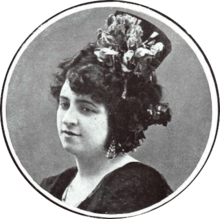Cuplé

Aurora Purificación Mañanós Jauffret (1891–1950), «La Goya», in 1914
The cuplé was a popular risqué Spanish theatre song style in the late years of the 19th century. From 1893–1911 the songs were a feature of the "género ínfimo" (lowest type) cabaret theatre sung by solo female singers, or men in drag, and attended mainly by men. But in the second decade of the 20th century the cuplé, in a more respectable form, became more family-friendly and was associated with the makings of stars of the Spanish theatre such as Aurora Jauffret, "La Goya".[1][2]
The term comes from French couplet, but the poetic form couplet in Spanish is a pareado or dístico. The cuplé prefigured the copla of the 1930s.
References
- ↑ Eva Woods Peiró White Gypsies: Race and Stardom in Spanish Musicals Page 70 2012 "A bastardization of the French couplet, the cuplé was a popular narrative song of approximately two to three minutes that most often recounted stories of prostitutes, lost love, sexual escapades, or the trials ofa poverty-stricken life. ...The cupletista was the female or male transvestite singer who usually performed cuplés in cafés, lyric theaters, and lowbrow theaters.5 According to Serge Salaün a cultural historian of the cuplé, the growing vogue for the cuplé in Spain developed alongside, within, and around the star system and, by extension, the cinema (El cuplé, 86, ..."
- ↑ Bradley S. Epps, Despina Kakoudaki All about Almodóvar: A Passion for Cinema 2009 "Even the cuplé, the song with which Montiel becomes identified, derives from a tradition of risqué musical numbers filled with sexual innuendo performed by women."
This article is issued from
Wikipedia.
The text is licensed under Creative Commons - Attribution - Sharealike.
Additional terms may apply for the media files.